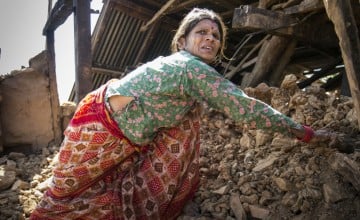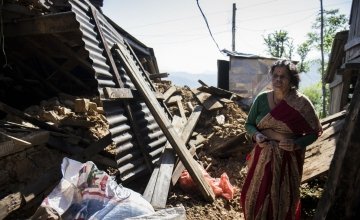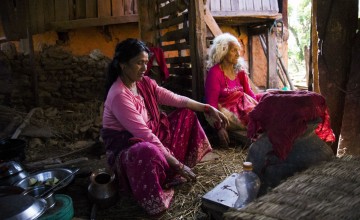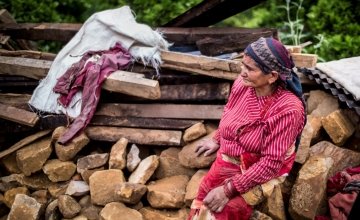
Read our 2023 annual report

Knowledge Hub
Empty nests: Nepal’s elderly struggle in the remote countryside

Even before the earthquake struck, Nepal’s rural communities suffered from stark isolation. In this series of portraits, we find out how the women of Nepal’s countryside villages are coping with terrible destruction in their small communities.
Isolated
Nepal’s fragmentary road network contributes to deep rural seclusion, but migration has also been a potent factor. In 2014, the Guardian reported that thousands of Nepalese women are working abroad under harrowing conditions. Last week, the New York Times noted the extraordinary exodus of young men from the countryside to work as labourers abroad – it’s estimated that up to a quarter of Nepal’s population is employed outside the country.
This absence has been painfully underlined in the aftermath of the earthquake in Nepal’s small villages, where the elderly (particularly women) are helpless while waiting for international relief to arrive. Concern's Crystal Wells and Kieran McConville have been speaking to some of the women left most vulnerable by the disaster.
Tulasa
Tulasa Aryal, fifty-eight, tries to salvage what she can from her earthquake-ravaged home in Bakrang, a village near the epicenter of the earthquake. Bakrang is among the hardest hit villages in the wake of the 7.8-magnitude earthquake that hit Nepal on April 25.
Tulasa, whose son has a mental disability and husband is too elderly for physical labour, is left to pick up the pieces largely on her own. “How can we spend our lives staying here?” she asks.
The monsoon is coming. We don’t know what we will do.
Chandra

Chandra Kumari, fifty-eight, tries to recover what rice she can from the ruins of her home in Bakrang. Unmarried and without children, Chandra lived in a home she inherited from her parents, farming the terraced hillsides.
While the children of some of Bakrang’s families have returned to help clear the wreckage, Chandra is combing through the rubble of her home by herself. “There are still a lot of things inside, but I can’t get through,” she says, motioning towards a pile of debris with a dust-covered hand. She explains that she stepped on a nail, injuring her foot, when climbing through the rubble.
Grains of rice are scattered across the ground, mixed with dirt and rocks. Chandra crouches down and combs through the rice, picking out pebbles and putting whatever kernels she can into a bag.
There is no place to go. I will have to stay here and eat this.
Laxmi

At 82, Laxmi Devi has been alive since the last catastrophic earthquake that struck Nepal in January 1934. During that earthquake, over 10,000 people died – the 2015 disaster is on the same tragic scale. Out of 793 houses homes in Bakrang, 515 were completely destroyed. In this photograph Laxmi and Chandra, fifty-one, prepare food in one of the few buildings still standing.
Shuvadra

Shuvadra Sapkota sits in the ruins of her home in the village of Kukhretar, Kabhreparanchok district. She and her husband, Krishna, had almost finished building a new house when the earthquake struck. Krishna says:
Everything we have is gone. It’s buried beneath the rubble.
Concern’s response
For the first phase of our emergency response, Concern is preparing to distribute shelter and relief items to 14,000 families in some of the hardest-hit districts. At the same time, we are working with one of our local partners to meet emergency water and sanitation needs are looking at providing families with access to cash. In all, we plan to reach more than 100,000 families through our relief work.
Follow Concern
Keep up to date with all of Concern's work and follow us on Instagram.


